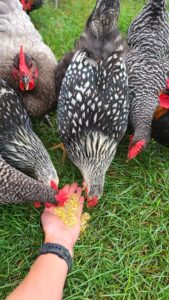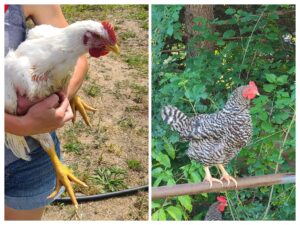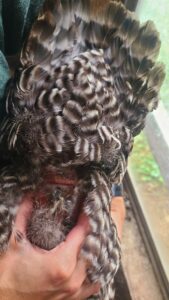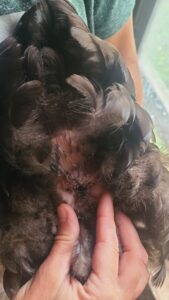There are a few things you can investigate to determine whether your laying hens are free-loading or contributing to your farm. Common egg laying indicators will be shown and discussed. Use this information to make cull decisions or establish pet status for specific birds in your flock.

This post contains affiliate links. As an Amazon Associate, I earn from qualifying purchases.
Is there such thing as having too many chickens?
That is a hard question that I have to ask myself every year. Each spring, I fall victim to the cuteness of the chicks at the feed mill. Then every autumn, I find myself calculating space in the coop and run which will be needed when a few feet of Michigan snow make free-ranging impossible.
I wish that I had more self-control and that I could keep them all, but we have done a lot of work to make our farm self-sustaining. Each person and animal here contributes and being a lovely, feathery lawn ornament doesn’t make the cut.
I know that sounds cold-hearted, but I want to assure you that we keep each of our chickens at least 5 years. During that time, they enjoy the freedom of scratching the yard for insects and worms and the goat pens for dropped sunflower seeds and corn. They get veggies from the garden, leftovers from our dinner table, oyster shell, and free-choice non-GMO grain. They are protected by a guardian dog by day and a secure coop by night. Our chickens seem genuinely content and we do adore them!
That being said, on a working farm, culling unproductive animals is necessary. I’m going to share in this article how I determine which hens are still laying and get fed all winter, and which assume the noble role of feeding our family.
Age of the Hen as an Indicator of Laying
Pullets, or young hens, start laying at 6 months of age and reach the peak of their egg production by 3 years of age. After the age of 3, they continue laying but not as regularly and some less-prolific breeds stop laying all together.
Pigmentation as an Indicator of Laying
Before they start laying, female chickens are fully pigmented with bright coloration of their eye ring, beak, legs, feet, and vent. However, the more eggs that they lay, the more bleached out they appear in those areas. As the hen ages and her production decreases, the pigmentation slowly comes back.
Take for example, the meat bird in the first picture below. This chicken is not laying and exhibits bright pigmentation of the legs and beak. In contrast, see how the Barred Rock hen in the second image differs. Her legs and beak are almost white instead of the deep yellow they used to be. This indicates that she is still producing plenty of eggs.

It’s important to familiarize yourself with breed standards so that you know what color skin/ pigmentation is normal for your chickens. I recommend getting a copy of the APA Standard of Perfection.
Abdomen and Vent Assessment as an Indicator of Laying
The last way to tell if your hens are laying is more hands-on. While holding the chicken upside down, examine the vent area. The vent is the opening where eggs and waste exit the hen’s body. On each side of the vent are her pubic bones. Observing the distance between them and pushing on them gently can reveal if she is currently laying. In a hen that is laying, the pubic bones are well separated (you can fit about 3 fingers between them) and flexible. In contrast, in a hen that isn’t laying, the pubic bones are close together and rigid.


After you have checked out the vent area, move your hand down to feel the abdomen. The abdomen is between the vent and the legs. A hen that is laying will have a soft abdomen, while one that is not will have a firm abdomen.
What to Do with a Non-Laying Hen
If you are okay with supporting free-loaders, you can let your non-laying hens retire and live out the rest of their lives as pets. Or, you can do what we do and humanely harvest them. The meat from old hens can be tough but it is still good, we breast them out and use the rest for soup.

Mother, farmer, author, and teacher by trade… She loves tending to things and watching them grow!
